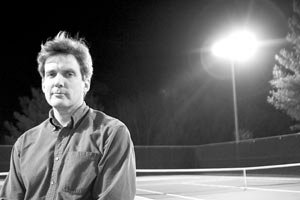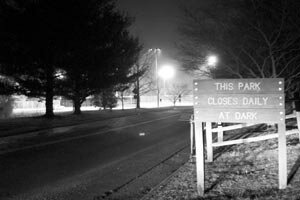Lit up: Neighbors angry over Pen Park lights
"Let there be light!" God said.
While Charlottesville officials may have taken His command to heart when they planned the renovation of Pen Park, neighbors say the new tennis court lights are an ungodly sight.
"It looks like E.T. landing," says Clara Belle Wheeler, who claims she can see the lights from her historic farm nearly a mile away on Stony Point Road.
The lights are so bright, Wheeler says, that she can read a newspaper outside at night. And some of her neighbors tell her they have to close their curtains to eat dinner without a glare.
That might not seem like a big deal to city dwellers accustomed to dining beside streetlamps, but Wheeler lives in Albemarle County.
Wheeler says part of her farm's appeal over the last 40 years has been the dark night sky, which her late mother fought to preserve by challenging the idea of any lighting at Darden Towe Park.
Her effort, in part, led to Albemarle's "dark skies ordinance," enacted in 1998 to regulate how and where lights can be put up. In 2003, the City followed suit with a dark skies ordinance of its own. That law limits outdoor lights to a height of 20 feet. The 50-foot-high Pen Park lights, set on a peninsula of city land surrounded by county, do not meet the criteria in either ordinance.
"They could be seen from space," astronomer and lighting expert Phil Ianna told City Council on Tuesday, March 7. Floodlights, used at both Pen Park and Tonsler Park, are "old-fashioned technology," he says. By contrast, the "shoebox" lights– a type UVA installed several years ago on its courts near Mem Gym– are state-of-the art.
Ianna also helped the County write its dark skies ordinance, part of which requires all public lighting to have shields that direct light downward and prevent "spillover."
Pen Park lights have none.
"There is no shielding on these lights," says Wheeler, "and they are huge wattage."
How huge?
A whopping 60,000 watts, says Paul Wright, president of the River Run condo neighborhood association in the community adjacent to the courts. Wright says he was shocked to see the forty 1,500-watt floodlights going up on 50-foot poles one day last August.
Though he'd seen construction work under way, Wright says he's troubled that the City never notified him or his neighbors about the renovation before work began.
"I didn't know what was going on," he says. "They could have been rewiring the golf shop."
Like Wheeler, Wright says the dark, starry night sky was one of the big assets of his neighborhood. Leading a reporter on a nighttime tour of River Run, Wright becomes a veritable shadow puppet standing in front of houses illuminated by the lights nearly half a mile away.
"When it's summer, they're going to be on all the time," he says. "Anyone can play tennis deep into the night."
And anyone can push his buttons. Wright says that tennis twosomes often drive up and push a button to illuminate four of the eight courts. Because the high-intensity lights take several minutes to power on, Wright says that players start jabbing at both buttons, and soon all eight courts are illuminated.
City Councilor Blake Caravati says he and other Council members just recently learned about the lights, and that the city's Department of Parks and Recreation is working on a solution.
"We realize there's an issue," says Mike Svetz, director of Parks and Rec. The project, he explains, was already under way when he arrived on the job last year.
"I'm trying to make the best of an unfortunate situation," he says.
Pat Plocek, then head of the city's parks department, oversaw the project, Svetz says, which also included resurfacing the courts and replacing the park's playground equipment.
Plocek, however, says the park project construction didn't get under way until July– a full five months after Svetz arrived on the scene.
"If he had any questions," says Plocek, "he should have asked them then."
The total cost for the renovation, including lights, was $250,000 half of which was covered by a federal grant. The lights themselves– made by Qualite Sports Lighting– cost $82,000.
So what to do now?
Wright and Wheeler say the answer's simple.
"I'm hoping they're removed," says Wright. But he suggests that, as an alternative, the poles could be cut in half.
"We live here because it's in the country. We want a rural life," seconds Wheeler. "To have the equivalent of a nuclear power station in your backyard is insane."
Svetz says its unlikely the lights will be removed because that would require the City to pay back the $41,000 it received in grant money. As for Wright's other suggestion, because of their design, the poles can't be cut in half, he insists.
That leaves shields as the most likely option. Svetz says he's ready to order the approximately $5,000 shields, which he believes will take care of the light pollution problem.
"I've done this in my past," he says. "It makes a huge difference."
Ianna disagrees.
"Shields would help, but you'll still be able to see those from a great distance," he says. "They're so high up in the air, and the floodlights are designed to spray light around."
If they spray their light to heaven, Svetz could have another problem on his hands.
"I can promise you my mother will come back and haunt anyone who puts lights up," jokes Wheeler.

Paul Wright says the Pen Park tennis court lights are a blight on his River Run neighborhood.

Apparently not
PHOTOS BY LAUREN BROOKS
#